Crepes, Chateaux and Mulberries
This is a new post of an old travelogue.
March 29, 2004 – April 3, 2004
It has been many months since I last saw Jessie, I couldn't say no to the request for me to visit and keep her company. After all since I worked out a business trip to London, Paris was just a hop, skip and a jump away. Little did I know I spent too much money on a plane ticket when I could have gone by train, spent too much time on the Metro when I could have gone by bus, spent too much imagination planning for metropolitan Paris when we ended up speeding through the Normandy/Brittany countryside.
My initial impressions of Paris were: dark night, sullen French teenagers rollerblading through the main train terminus. That's it for the 4 hours I saw of it when I got there. We took off for the countryside the next morning!
We went through three major areas – the Loire Valley, famous for wines and fertile ground and medieval and early renaissance architecture. Brittany, famous for some of the grandest chateux in the region and also Amboise, the home of Leonardo Da Vinci during his dying days. Normandy, of course, for WW2 and Omaha Beach, apples, and lesser known, Calvados, a very good port wine.
The Loire Valley gave me the impression of very traditional small-village lifestyle. The history and culture of the place peeks out at you – not very obvious or ostentatious, like Paris, but you can catch glimpses of an artist’s perception of the future, or a king’s dilemma between love and duty, all in perfect harmony with the stolid lifestyle of the French farmer’s day-to-day. My deepest impression was harmony. Everyone was in tune with everything. Even the gas station minimart looked right at home.
We passed Chateaux Chambord (King Francois the First’s Hunting “Lodge”) along the way. King Francois the First was a very big influence in the area, with most remarkable chateaux and cathedrals built in his honor. History has it he frequented this area for its lush wildlife and lush women – he was an avid hunter, and his lover Diana du Poitier lived here.
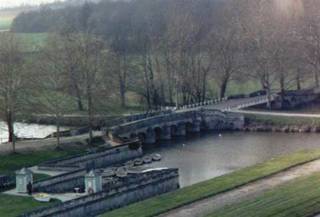
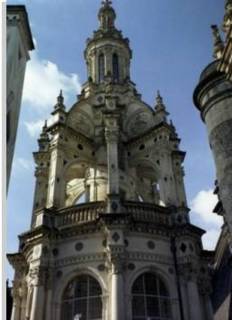
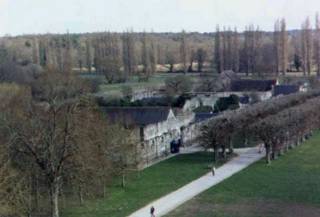
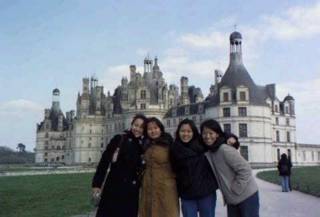
The Ladies at Chambord
There are two notable things we saw that I think deserve some space.. We first went to Leonardo DaVinci’s home, Close Luce. This was gifted to him by King Francois the First, and eventually was where da Vinci died. It is now a museum, displaying some of his original but lesser known work. It exhibited a lot about his life and work, as well as replicas of his inventions. It was a great place to visit – a very intelligent presentation of the man’s work.
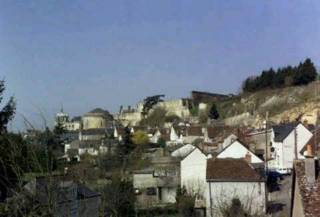
View from Leonardo da Vinci's bedroom at Close Luce
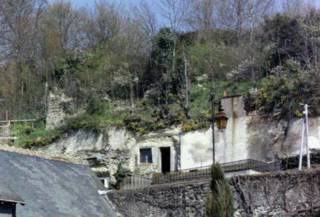
Houses built into rock in Amboise, town by Close Luce
We also spent a lot of time in Chateux Chenonceux – a grand mansion built by King Francois the First for his lover, Diane Du Poitier. The Chateux is known for its beautiful gardens and ornate architecture.
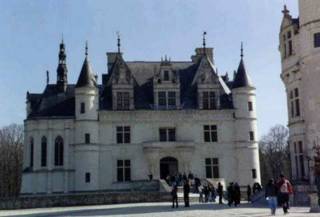
Chateaux Chenonceaux was rumoured to had inspired Cinderalla's castle in Disneyworld
The history of this place intrigues me. King Francois’ wife was Catherine de Medici, of the famous Italian Medicis; she took power and ruled France after King Francois died. She booted Diane du Poitier from this chateux, and ruled France from her reading room overlooking the chateaux grounds. There are other rooms here that subsequent royal women stayed in, including Louise de Lorraine, who mourned her dead King for the rest of her life – her room was done entirely in black and silver and decorated for piety. She never left her room until it was time to die.
The gardens were designed for lovers to walk through – each corner to provide delight at the gifts of nature. It is indeed a Chateux built by women for women. When you look at the way the chateux is decorated, or as you walk through the rooms, you may faintly hear the edge of a royal gown sweeping on the stone floor. Perhaps, someone weeping behind closed doors for lost love. Or maybe even overhear an impassioned speech from the library about a kingdom's future.
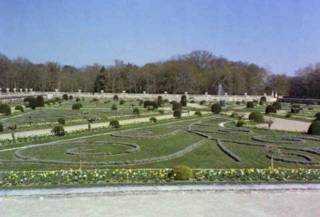
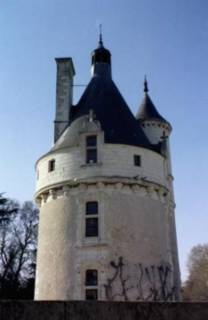
From the Loire, we sped in our little minivan into Brittany, where we started to smell fish in the air. Between the lush valleys and the salty beaches, we saw green fields and fertile farms transition abruptly into endless vistas of sandbars. In Brittany, we experienced the futile hunt for the perfect crepe, and a spiritual visit to the Abbey at Mont St Michel.
Brittany is famous for its crepes and seafood, therefore we were on the hunt for the classic crepe, and some fresh fish. The journey was paved with rubbery floppy cold pre-made crepes, thick underdone pancake-like crepes, crispy wafer-like crepes... we can only find so many bad crepes in a one-day trip of Brittany right? Well we didn’t find the perfect crepe. Disappointment #1. We did have some grand meals at a pensione we stayed in -- we couldn't make heads or tails out of the menu but took our best guesses and pointed at dishes served at the next table if we liked the looks of them. Turned out we were luckier at guess-ordering than we were at crepe-hunting -- I had sweetbread for the second time in my life, and I have to say I liked it considerably more than the first.
The next morning we went on to Mont St Michel. The village is at the end of the world. It faces an awesome expanse of sandbars that lead out to the Island of St Michel, and when the tide comes in, everything is flooded in about 10 meters per minute. It is a fortified village that used to be an abbey -- monks would reflect and study here while kings and knights would congregate and plan their empires. A building that was constructed from stone, it cleaves into the rock structure of the St Michel cliffs like a barnacle gone awry – almost as if it was part of the cliffs’ natural structure. Due to the cliff’s gradient, various halls in the abbey were built to support other halls above it. The lowest hall contained pillars about 6 feet wide in diameter, many of them holding up the ultimate structure against the side of the rocky cliffs.
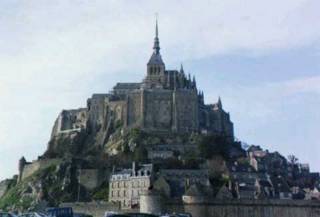
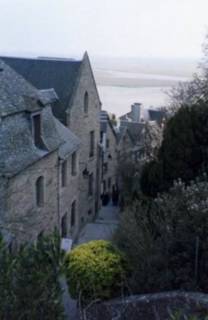
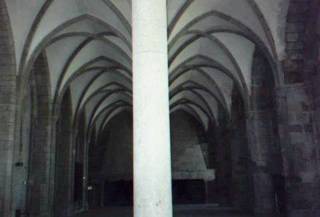
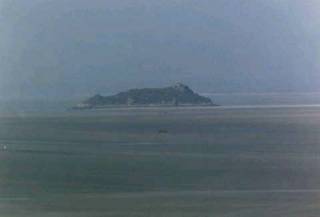
Pilgrims across the sandbars towards Isle St Michel
The fortified village contains steep, narrow and winding paths, you can see where the peasants would have constructed their houses to face the sea, and the walls to face the only narrow road that leads out to the peninsula. It is a location that is naturally defensible, yet so small, it is quite amazing it held off an English siege in the 16th century for over 30 years.
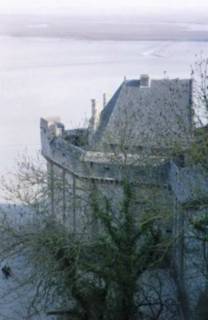
Crepe-less but quite enchanted with medieval history, we drove on to Normandy, and received a dose of modern history. Normany gave me the impression of an uneasy peace. In Arromanche, also known as "Sword Beach", the aura of WW2 is tangible, you can almost feel it on your skin as you walk along the beaches. Yet the villages are peaceful, quaint – they also sell many WW2 memorabilia and postcards of Mussolini getting beat up by a GI. It was also ironic being there, given the circumstances under which America participated in the world war then, and what it is doing now. The level of antipathy in this area against America is confounding considering the U.S. was known as a liberator during the 1940’s.

The village of Arromanche - "Sword Beach"
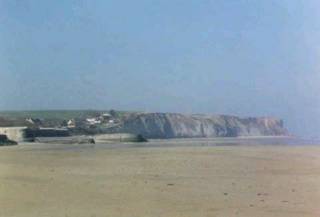
2004 is the 60th anniversary of the American forces’ landing on Omaha beach in Normandy on June 6 1944. Here in Arromanche there are still remains of mulberry bridges (floating connectors named after the engineer that invented them) and piers that the army used for its supply lines during the war. You can imagine how hard it was to gain ground on the expansive beach, how much killing space was available for the Germans to set up land minds and trip wires. Funny how beautiful it looked the day we were there – I don’t know if the GI’s had good weather when they landed, but if you half-close your eyes, the satellite dishes and new construction falls away and you may actually see the cliffs then as the soldiers did. It was an eerie empathy.
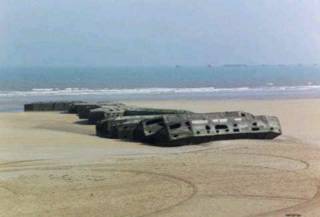
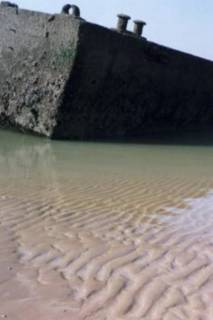
This was a fun short trip - I had loads of laughs with my friends playing screwed up Gin Rummy and trying to make up rules as we go along, making fun of each other about ghosts in the chateux, savoring French cuisine ranging from buttery croissants, creamy home-made yoghurt, to the most heavenly and complex sauces and full-bodied wine. What a luxurious trip! Sometimes the level of opulence experienced by my tastebuds was so overwhelming I almost wished for a Diet Coke and potato crisps, but I did manage to resist and had a glass of Burgundy red with a soufflé de potate instead.
The little journey ends with another nighttime glimpse of Paris, we had dinner in a little fish restaurant in the Left Bank and went for a leisurely stroll by the Hotel deVille. As thirty-year-olds we couldn't resist smiling and saying bounjour to various good-looking men that passed us, including one that had a lovely smile (I like to think it was a smile meant for me) but fortunately (or not?) spring-time in Paris did not result in anything more than mild flirtations.
Unfortunately Charles du Gaulle airport left a sour taste in my mouth - my backpack was picked while walking on the travelator to the terminal. Nothing was taken, probably because my backpack had so much crap in it, but I didn't appreciate the choking sense of panic and violation when I saw the zippers wide open. (As luck would have it, the terminal I was in was the same one that collapsed a few months later)
Heading south next time! Marseilles and Nice, here I come.
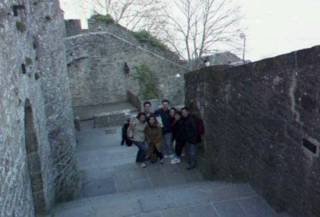
Yoko, Chris, me, Rob, Weiling, Jess, Ian
For more pictures from Normandy and Brittany, please go http://pg.photos.yahoo.com/ph/patsianlow/album?.dir=2344&.src=ph
March 29, 2004 – April 3, 2004
It has been many months since I last saw Jessie, I couldn't say no to the request for me to visit and keep her company. After all since I worked out a business trip to London, Paris was just a hop, skip and a jump away. Little did I know I spent too much money on a plane ticket when I could have gone by train, spent too much time on the Metro when I could have gone by bus, spent too much imagination planning for metropolitan Paris when we ended up speeding through the Normandy/Brittany countryside.
My initial impressions of Paris were: dark night, sullen French teenagers rollerblading through the main train terminus. That's it for the 4 hours I saw of it when I got there. We took off for the countryside the next morning!
We went through three major areas – the Loire Valley, famous for wines and fertile ground and medieval and early renaissance architecture. Brittany, famous for some of the grandest chateux in the region and also Amboise, the home of Leonardo Da Vinci during his dying days. Normandy, of course, for WW2 and Omaha Beach, apples, and lesser known, Calvados, a very good port wine.
The Loire Valley gave me the impression of very traditional small-village lifestyle. The history and culture of the place peeks out at you – not very obvious or ostentatious, like Paris, but you can catch glimpses of an artist’s perception of the future, or a king’s dilemma between love and duty, all in perfect harmony with the stolid lifestyle of the French farmer’s day-to-day. My deepest impression was harmony. Everyone was in tune with everything. Even the gas station minimart looked right at home.
We passed Chateaux Chambord (King Francois the First’s Hunting “Lodge”) along the way. King Francois the First was a very big influence in the area, with most remarkable chateaux and cathedrals built in his honor. History has it he frequented this area for its lush wildlife and lush women – he was an avid hunter, and his lover Diana du Poitier lived here.




The Ladies at Chambord
There are two notable things we saw that I think deserve some space.. We first went to Leonardo DaVinci’s home, Close Luce. This was gifted to him by King Francois the First, and eventually was where da Vinci died. It is now a museum, displaying some of his original but lesser known work. It exhibited a lot about his life and work, as well as replicas of his inventions. It was a great place to visit – a very intelligent presentation of the man’s work.

View from Leonardo da Vinci's bedroom at Close Luce

Houses built into rock in Amboise, town by Close Luce
We also spent a lot of time in Chateux Chenonceux – a grand mansion built by King Francois the First for his lover, Diane Du Poitier. The Chateux is known for its beautiful gardens and ornate architecture.

Chateaux Chenonceaux was rumoured to had inspired Cinderalla's castle in Disneyworld
The history of this place intrigues me. King Francois’ wife was Catherine de Medici, of the famous Italian Medicis; she took power and ruled France after King Francois died. She booted Diane du Poitier from this chateux, and ruled France from her reading room overlooking the chateaux grounds. There are other rooms here that subsequent royal women stayed in, including Louise de Lorraine, who mourned her dead King for the rest of her life – her room was done entirely in black and silver and decorated for piety. She never left her room until it was time to die.
The gardens were designed for lovers to walk through – each corner to provide delight at the gifts of nature. It is indeed a Chateux built by women for women. When you look at the way the chateux is decorated, or as you walk through the rooms, you may faintly hear the edge of a royal gown sweeping on the stone floor. Perhaps, someone weeping behind closed doors for lost love. Or maybe even overhear an impassioned speech from the library about a kingdom's future.


From the Loire, we sped in our little minivan into Brittany, where we started to smell fish in the air. Between the lush valleys and the salty beaches, we saw green fields and fertile farms transition abruptly into endless vistas of sandbars. In Brittany, we experienced the futile hunt for the perfect crepe, and a spiritual visit to the Abbey at Mont St Michel.
Brittany is famous for its crepes and seafood, therefore we were on the hunt for the classic crepe, and some fresh fish. The journey was paved with rubbery floppy cold pre-made crepes, thick underdone pancake-like crepes, crispy wafer-like crepes... we can only find so many bad crepes in a one-day trip of Brittany right? Well we didn’t find the perfect crepe. Disappointment #1. We did have some grand meals at a pensione we stayed in -- we couldn't make heads or tails out of the menu but took our best guesses and pointed at dishes served at the next table if we liked the looks of them. Turned out we were luckier at guess-ordering than we were at crepe-hunting -- I had sweetbread for the second time in my life, and I have to say I liked it considerably more than the first.
The next morning we went on to Mont St Michel. The village is at the end of the world. It faces an awesome expanse of sandbars that lead out to the Island of St Michel, and when the tide comes in, everything is flooded in about 10 meters per minute. It is a fortified village that used to be an abbey -- monks would reflect and study here while kings and knights would congregate and plan their empires. A building that was constructed from stone, it cleaves into the rock structure of the St Michel cliffs like a barnacle gone awry – almost as if it was part of the cliffs’ natural structure. Due to the cliff’s gradient, various halls in the abbey were built to support other halls above it. The lowest hall contained pillars about 6 feet wide in diameter, many of them holding up the ultimate structure against the side of the rocky cliffs.




Pilgrims across the sandbars towards Isle St Michel
The fortified village contains steep, narrow and winding paths, you can see where the peasants would have constructed their houses to face the sea, and the walls to face the only narrow road that leads out to the peninsula. It is a location that is naturally defensible, yet so small, it is quite amazing it held off an English siege in the 16th century for over 30 years.

Crepe-less but quite enchanted with medieval history, we drove on to Normandy, and received a dose of modern history. Normany gave me the impression of an uneasy peace. In Arromanche, also known as "Sword Beach", the aura of WW2 is tangible, you can almost feel it on your skin as you walk along the beaches. Yet the villages are peaceful, quaint – they also sell many WW2 memorabilia and postcards of Mussolini getting beat up by a GI. It was also ironic being there, given the circumstances under which America participated in the world war then, and what it is doing now. The level of antipathy in this area against America is confounding considering the U.S. was known as a liberator during the 1940’s.

The village of Arromanche - "Sword Beach"

2004 is the 60th anniversary of the American forces’ landing on Omaha beach in Normandy on June 6 1944. Here in Arromanche there are still remains of mulberry bridges (floating connectors named after the engineer that invented them) and piers that the army used for its supply lines during the war. You can imagine how hard it was to gain ground on the expansive beach, how much killing space was available for the Germans to set up land minds and trip wires. Funny how beautiful it looked the day we were there – I don’t know if the GI’s had good weather when they landed, but if you half-close your eyes, the satellite dishes and new construction falls away and you may actually see the cliffs then as the soldiers did. It was an eerie empathy.


This was a fun short trip - I had loads of laughs with my friends playing screwed up Gin Rummy and trying to make up rules as we go along, making fun of each other about ghosts in the chateux, savoring French cuisine ranging from buttery croissants, creamy home-made yoghurt, to the most heavenly and complex sauces and full-bodied wine. What a luxurious trip! Sometimes the level of opulence experienced by my tastebuds was so overwhelming I almost wished for a Diet Coke and potato crisps, but I did manage to resist and had a glass of Burgundy red with a soufflé de potate instead.
The little journey ends with another nighttime glimpse of Paris, we had dinner in a little fish restaurant in the Left Bank and went for a leisurely stroll by the Hotel deVille. As thirty-year-olds we couldn't resist smiling and saying bounjour to various good-looking men that passed us, including one that had a lovely smile (I like to think it was a smile meant for me) but fortunately (or not?) spring-time in Paris did not result in anything more than mild flirtations.
Unfortunately Charles du Gaulle airport left a sour taste in my mouth - my backpack was picked while walking on the travelator to the terminal. Nothing was taken, probably because my backpack had so much crap in it, but I didn't appreciate the choking sense of panic and violation when I saw the zippers wide open. (As luck would have it, the terminal I was in was the same one that collapsed a few months later)
Heading south next time! Marseilles and Nice, here I come.

Yoko, Chris, me, Rob, Weiling, Jess, Ian
For more pictures from Normandy and Brittany, please go http://pg.photos.yahoo.com/ph/patsianlow/album?.dir=2344&.src=ph

0 Comments:
Post a Comment
<< Home